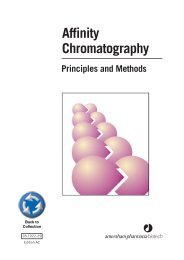Tabletop Rotors and Tubes
Tabletop Rotors and Tubes
Tabletop Rotors and Tubes
You also want an ePaper? Increase the reach of your titles
YUMPU automatically turns print PDFs into web optimized ePapers that Google loves.
1<br />
<strong>Rotors</strong><br />
This section is an introduction to the Beckman Coulter family of<br />
tabletop preparative ultracentrifuge rotors, providing general information<br />
on rotor design, selection, <strong>and</strong> operation. Rotor designs<br />
described are fixed angle, swinging bucket, vertical tube, <strong>and</strong> near<br />
vertical tube type. Specific instructions for using each type of rotor<br />
are contained in Section 4. Care <strong>and</strong> maintenance information for all<br />
of these rotors is contained in Section 5.<br />
GENERAL DESCRIPTION<br />
ROTOR DESIGNATIONS<br />
Beckman Coulter tabletop preparative rotors are named according<br />
to the type of rotor <strong>and</strong> the rotor’s maximum allowable revolutions<br />
per minute (in thous<strong>and</strong>s), referred to as rated speed. For example,<br />
the TLS-55 is a swinging bucket rotor with a maximum speed of<br />
55 000 rpm. Decimal units that are sometimes part of the rotor<br />
name, as in the TLA-120.2 <strong>and</strong> the TLA-120.3, make it possible<br />
to distinguish between different rotors that have the same maximum<br />
allowable speed. An example of each rotor type is shown in<br />
Figure 1-1.<br />
<strong>Tubes</strong> in fixed angle rotors (designated MLA or TLA) are held at an<br />
angle to the axis of rotation in numbered tube cavities. The bodies of<br />
some rotors are fluted to eliminate unnecessary weight <strong>and</strong> minimize<br />
stresses.<br />
In swinging bucket rotors (designated MLS or TLS), containers are<br />
held in rotor buckets attached to the rotor body by hinge pins or a<br />
crossbar. The buckets swing out to a horizontal position as the rotor<br />
accelerates, then seat against the rotor body for support.<br />
<strong>Tabletop</strong> Ultracentrifuge <strong>Rotors</strong> <strong>and</strong> <strong>Tubes</strong><br />
1-1

















